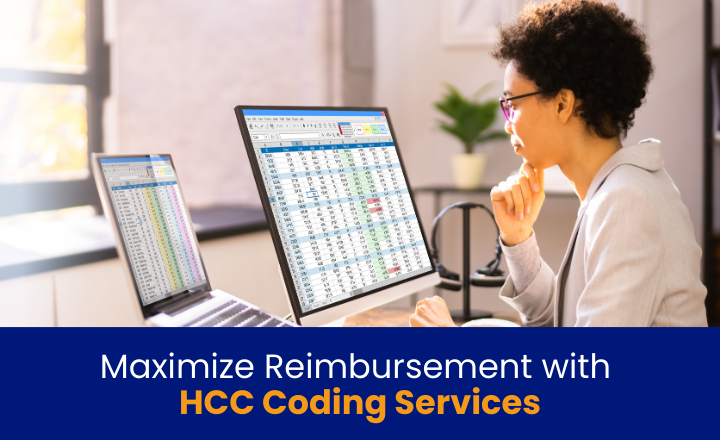The Revenue Cycle Blog
Filter By
- ABA Therapy Billing
- AI in Medical Billing
- AI in Revenue Cycle
- Accounts Receivable Management
- Accounts Receivable Mangement
- Allergy and Immunology Billing Services
- Anesthesia Billing Services
- Back Office Revenue Cycle
- Bariatric Surgery Billing
- Billing For Physician Practice and Medical Groups
- Billing for Physician Practices and Medical Groups
- Blog
- COVID-19 Billing
- CPT Codes
- Cardiology Billing Services
- Charge Capture Services
- Charge Entry - Medical Billing
- Charge Entry Services
- Clinical Documentation Improvement - CDI
- Clinical Documentation Integrity
- Company News
- Credit Balance Services
- DME Billing Services
- Denial Code CO-97
- Denial Management - Medical Billing
- Dermatology Billing Services
- E&M
- Electronic Health Records
- Eligibility and Benefits Verification Services
- Emergency Department Billing Services
- FAQs
- G Code
- Gastroenterology Billing Services
- General Surgery Billing Services
- HCC Coding
- HCC Coding Services
- HCPCS
- Healthcare Collections
- Hospitals
- Internal Medicine Billing Services
- Medical Billing Company
- Medical Billing Services
- Medical Billing Services in California
- Medical Billing Services in Texas
- Medical Claim Submission
- Medical Coding Services
- Mental health Billing Services
- Mid Cycle in Revenue Cycle
- Modifiers in Medical Coding
- Neonatal Billing Services
What Is Prior Authorization? The Ultimate Checklist for 24-Hour Turnarounds
What is prior authorization? This guide breaks down requirements, delays, and a checklist to help providers reach faster approvals with 24-hour turnaround.
Top 15 Proven Gastroenterology CPT Codes for Better Billing Results
Top 15 proven Gastroenterology CPT Codes every GI practice needs to improve billing, reduce denials, and secure faster reimbursements with confidence.
Unlocking Lost Revenue: A Guide to Auditing Your Charge Capture Process
Charge capture errors drain millions from healthcare organizations every year. A structured audit, paired with a Charge Capture ROI Calculator, empowers providers to uncover missed charges, recover revenue, and build a culture of compliance and accuracy.
How to Properly Code Left Knee Pain with ICD-10: A Billing Guide
Coding left knee pain may seem straightforward, but incorrect ICD-10 use often leads to denials and delayed payments. This billing guide explains how to properly code left knee pain with ICD-10 (M25.562), including injury vs. chronic scenarios, documentation requirements, and tips to prevent costly coding mistakes.
HCFA 1500 and CMS-1500 Claims: The Billing Guide Every Practice Needs
The HCFA 1500 form (CMS-1500) is the cornerstone of professional medical billing. This guide explains who uses it, how to fill it out correctly, common errors, and proven strategies to reduce denials and accelerate payments. A must-read for providers and billing teams.
The Accounts Receivable Black Hole: How to Recover Lost Revenue in ABA Therapy
Accounts receivable backlogs drain ABA therapy practices of revenue. This guide explains why AR problems occur, warning signs to watch for, industry benchmarks, and practical strategies to recover lost income and keep cash flow steady.
The BCBA’s Guide to Billing for RBT Supervision: Rules, Codes and Best Practices
RBT supervision billing can be complex for BCBAs, with strict payer rules and documentation requirements. This guide explains CPT codes, common mistakes, and best practices for billing supervision accurately while reducing denials and staying compliant.
Specialized Hematology-Oncology Billing: Why Generic Services Can’t Handle Complex Drug Claims
Oncology practices rely heavily on high-cost drug claims, making billing accuracy critical. This blog explains why generic billing services fail and how specialized hematology-oncology billing—through expertise in J-Codes, modifiers, prior authorization, and payer rules—ensures full reimbursement and protects your revenue cycle.
Top ICD-10 Codes in Dermatology Billing You Must Know in 2025
ICD-10 coding is the backbone of dermatology billing. In 2025, updated codes for cancers, dermatitis, psoriasis, and acne are shaping insurance claims. A skilled Dermatology Billing Company helps practices reduce denials and stay compliant.
CPT Codes for Urinary Catheter Insertions: Simple vs. Complicated Billing
Accurate use of CPT codes 51701, 51702, and 51703 is critical in urinary catheter billing. This guide explains simple vs. complicated catheterization, documentation rules, and audit compliance.
Maximizing Revenue & Compliance: Postoperative and Follow-Up Billing for Bariatric Surgery
Postoperative billing in bariatric surgery is often overlooked, leading to lost revenue and audit risks. Learn how to bill correctly for follow-ups, complications, telehealth, and nutrition counseling.
Boost Your Revenue Cycle: How HCC Coding Services Maximize Reimbursement
Accurate HCC coding is the foundation of a healthy revenue cycle. From higher reimbursement to reduced audit risk, here’s how professional coding services protect both compliance and profitability.
How to Appeal Justified Oncology Denials: Stop Writing Off Revenue (A Step-by-Step Appeals Strategy)
Too many oncology practices write off justified denials as lost revenue. This guide outlines a proven, step-by-step strategy for oncology billing appeals—covering prior authorizations, J-Codes, LCD/NCD compliance, and underpayment recovery to protect margins and improve oncology RCM outcomes.
Proactive Prevention: How to Stop Credit Balances Before They Start
Credit balances drain resources, frustrate patients, and raise compliance risks. Instead of fixing them after the fact, learn how proactive strategies—like accurate eligibility checks, standardized collections, and automated posting—can stop them from forming in the first place.
The Patient Experience: How a Credit Balance Can Damage Trust
Credit balances may look minor, but they impact trust. Mishandled refunds frustrate patients, while transparent policies and communication strengthen loyalty.
A Roadmap for New Practices: How to Get Credentialed and Ready for Business
Launching a new medical practice? This guide walks you through every step — from gathering documents and CAQH setup to Medicare PECOS enrollment and ongoing monitoring — so your practice is ready for patients and revenue from day one.
The Timely Filing Tightrope: Don’t Let Your Claims Expire
Timely filing may seem like a small compliance step, but missing payer deadlines can permanently erase revenue. This blog explains why claims expire, the true cost of timely filing denials, and the practical workflows every provider needs.
Forgetting is Costly: How Clinicians Can Improve Charge Capture at the Point of Care
Charge capture is one of the most overlooked revenue cycle steps — yet it directly determines whether your services are reimbursed or lost to missed documentation. Clinicians are the first line of defense.
The Strategic Imperative of Patient Appointment Scheduling
Patient appointment scheduling is more than a back-office task — it’s a core driver of patient access, provider efficiency, and financial performance. By integrating scheduling with Revenue Cycle Management (RCM), healthcare providers can reduce no-shows, improve collections, and enhance the patient experience. Learn how modern scheduling transforms healthcare operations.
Solving the Puzzle: A Guide to Handling Payment Posting Exceptions
Payment posting exceptions—such as partial payments, unexplained write-offs, and denial codes—often create confusion and revenue leakage. In this guide, we outline clear strategies to standardize exception handling, protect accuracy, and keep your revenue cycle running smoothly.




















